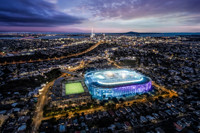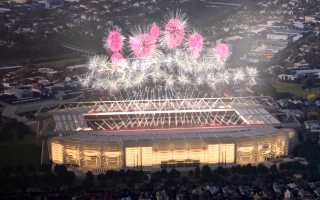Eden Park 2.1
| Capacity | 60 000 |
|---|---|
| Country | New Zealand |
| City | Auckland |
| Clubs | NZ Warriors, Auckland Blues, Auckland FC |
| Category | Design awaiting implementation |
| Cost | ? |
| Construction | ? |
| Design | Jasmax |
Advertisement
Eden Park 2.1 – design description
What is the Eden Park 2.1 project in a nutshell?
The project involves the expansion of Eden Park in Auckland, the largest and most important stadium in New Zealand. The expansion is to be a continuation, in a sense, of the work that was carried out before the 2011 Rugby World Cup, when a new south stand was built.
This time, the north side of the stadium is to be rebuilt – in a similar style to the south side, giving the facility a symmetrical appearance. In addition, the plan calls for a retractable roof to enclose the space above the field.
At the bottom of the stands will be mobile segments that, when pushed back, will create space for an oval cricket pitch. The work is to be spread over three stages – the first two will be the reconstruction of the lower and upper parts of the northern stand, respectively, while the third will see the construction of a retractable roof.
The project was part of a long dispute over a major stadium for Auckland and all of New Zealand, and had strong competition from various plans to build a new stadium near the city center.
In the end, the City Council backed the project to upgrade the distinguished Eden Park, but its implementation is still dependent on raising funds – the first phase depends on the allocation of government funds, the next two phases will be contingent on the involvement of private partners.
How did the Eden Park expansion project come about?
How does Eden Park present itself?
The history of Eden Park dates back to 1900, and over the years the facility has become the largest stadium in New Zealand and is even sometimes referred to as the national stadium. The stadium has hosted many international events and has become the stronghold of New Zealand's rugby union team (the popular “All Blacks”). The facility is located approx. 4 km south of Auckland's city center.
Eden Park is suitable for both rugby and football matches, as well as cricket, which requires an oval pitch. Multifunctionality is an advantage on the one hand, while on the other hand it is pointed out that rugby should be played in a stadium dedicated to this discipline. The facility, moreover, is no longer among the most modern, even despite continued investment – plus it is having issues with profitability.
Why was the Eden Park expansion project conceived?
There have been talks for some time that a new stadium should be built in Auckland – one that is fit for the 21st century and the ambitions of New Zealand's largest metropolitan area, worthy of being referred to as a “national stadium”. The issue of building a new stadium has grown into a broad community discussion. Among the various ideas and concepts, the idea of building an entirely new facility on the waterfront, in downtown Auckland, led the way.
The first serious attempt to replace Eden Park was the “Stadium New Zealand” concept, which involved building a new stadium on the Bledisloe Wharf. The idea was conceived in 2006 and was linked to the awarding of the 2011 Rugby World Cup to New Zealand, but the project eventually fell through in favor of upgrading Eden Park (a new south stand was then built at the stadium).
However, the construction of the new stand did not solve all of Eden Park's problems, and there were still calls for a new stadium. The facility's managers (Eden Park Trust), aware of the need to increase the attractiveness and upgrade the arena, began working on a new concept for modernization. The project, dubbed Eden Park 2.0 (later the name Eden Park 2.1 began to be used), was presented on April 28, 2023.
What does the Eden Park 2.1 concept entail?
The main idea proposed by the Eden Park Trust is to build a new northern stand (corresponding to the southern stand, commissioned in 2010) and equip the facility with a retractable roof.
Once the new stand is built, the facility will take on a more rectangular form. Thanks to the mobile sections of the stands in the lower part, however, the possibility of playing cricket matches will be preserved.
How is the Eden Park expansion to be implemented?
The plan is to spread the investment over three stages. In the first stage, the lower tier of the northern stand is to be rebuilt, with the installation of mobile segments. The second stage is to rebuild the upper part of the same stand so that it looks similar to the south stand. The third stage will feature the construction of an enclosed roof.
The first phase is expected to cost NZ$110 million, and the Eden Park Trust is hoping to secure this funding from the government. The remaining two phases are to be built with private funds and are dependent on finding partners.
Will the Eden Park 2.1 project come to fruition?
In September 2023, Auckland authorities once again attempted to resolve the stadium dispute by inviting interested parties to submit their proposals.
As of October 2023, as many as eight projects had been proposed, although four concepts were ultimately at stake: in addition to the Eden Park expansion, three more aimed to build entirely new facilities in the city center: the Te Tōangaroa Auckland Stadium, the Auckland Waterfront Stadium and the National Stadium at Wynyard Point.
On May 31, 2024, the City Council narrowed the list of projects under consideration to two: the expansion of Eden Park and the construction of the new Te Tōangaroa Auckland Stadium.
The spectacular Te Tōangaroa Auckland Stadium project definitely stood out from the other concepts presented. The Eden Park expansion, on the other hand, was argued for by its more than 120-year tradition. In both cases, however, there were funding concerns, especially since the City Council did not intend to contribute to the investment.
In the end, on March 27, 2025, the City Council voted to support the Eden Park expansion plans. The implementation of the investment now depends on raising funds – in order to move forward with the first phase, the needed funds (NZ$110 million) must be allocated by the government.
Advertisement

 StadiumDB
StadiumDB














